Chantal Amrhein
A comparison of translation performance between DeepL and Supertext
Feb 04, 2025Abstract:As strong machine translation (MT) systems are increasingly based on large language models (LLMs), reliable quality benchmarking requires methods that capture their ability to leverage extended context. This study compares two commercial MT systems -- DeepL and Supertext -- by assessing their performance on unsegmented texts. We evaluate translation quality across four language directions with professional translators assessing segments with full document-level context. While segment-level assessments indicate no strong preference between the systems in most cases, document-level analysis reveals a preference for Supertext in three out of four language directions, suggesting superior consistency across longer texts. We advocate for more context-sensitive evaluation methodologies to ensure that MT quality assessments reflect real-world usability. We release all evaluation data and scripts for further analysis and reproduction at https://github.com/supertext/evaluation_deepl_supertext.
Machine Translation Meta Evaluation through Translation Accuracy Challenge Sets
Jan 29, 2024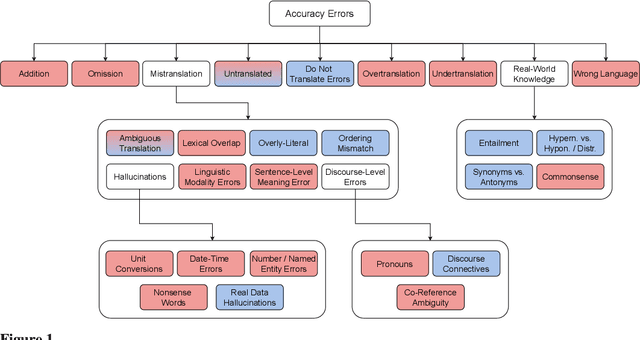
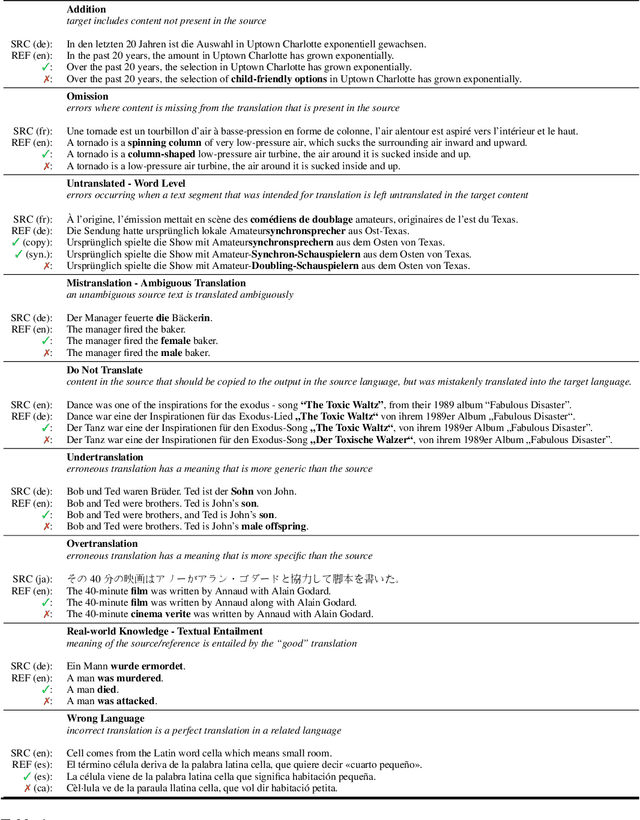
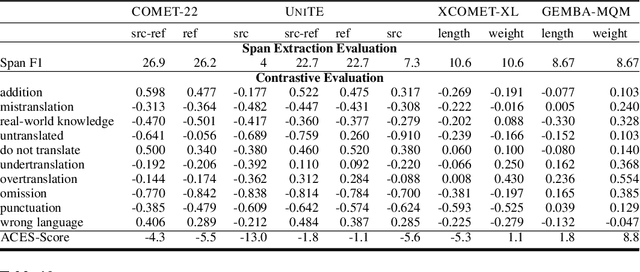
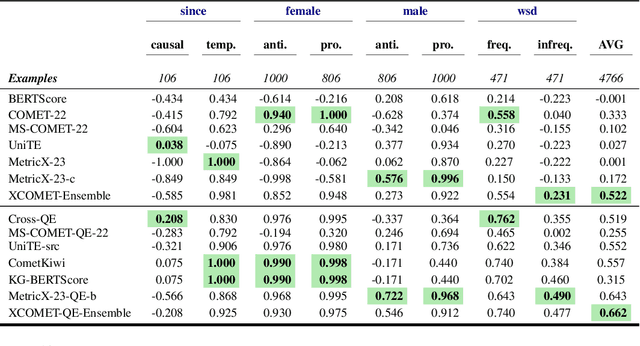
Abstract:Recent machine translation (MT) metrics calibrate their effectiveness by correlating with human judgement but without any insights about their behaviour across different error types. Challenge sets are used to probe specific dimensions of metric behaviour but there are very few such datasets and they either focus on a limited number of phenomena or a limited number of language pairs. We introduce ACES, a contrastive challenge set spanning 146 language pairs, aimed at discovering whether metrics can identify 68 translation accuracy errors. These phenomena range from simple alterations at the word/character level to more complex errors based on discourse and real-world knowledge. We conduct a large-scale study by benchmarking ACES on 50 metrics submitted to the WMT 2022 and 2023 metrics shared tasks. We benchmark metric performance, assess their incremental performance over successive campaigns, and measure their sensitivity to a range of linguistic phenomena. We also investigate claims that Large Language Models (LLMs) are effective as MT evaluators by evaluating on ACES. Our results demonstrate that different metric families struggle with different phenomena and that LLM-based methods fail to demonstrate reliable performance. Our analyses indicate that most metrics ignore the source sentence, tend to prefer surface-level overlap and end up incorporating properties of base models which are not always beneficial. We expand ACES to include error span annotations, denoted as SPAN-ACES and we use this dataset to evaluate span-based error metrics showing these metrics also need considerable improvement. Finally, we provide a set of recommendations for building better MT metrics, including focusing on error labels instead of scores, ensembling, designing strategies to explicitly focus on the source sentence, focusing on semantic content and choosing the right base model for representations.
A Benchmark for Evaluating Machine Translation Metrics on Dialects Without Standard Orthography
Nov 28, 2023



Abstract:For sensible progress in natural language processing, it is important that we are aware of the limitations of the evaluation metrics we use. In this work, we evaluate how robust metrics are to non-standardized dialects, i.e. spelling differences in language varieties that do not have a standard orthography. To investigate this, we collect a dataset of human translations and human judgments for automatic machine translations from English to two Swiss German dialects. We further create a challenge set for dialect variation and benchmark existing metrics' performances. Our results show that existing metrics cannot reliably evaluate Swiss German text generation outputs, especially on segment level. We propose initial design adaptations that increase robustness in the face of non-standardized dialects, although there remains much room for further improvement. The dataset, code, and models are available here: https://github.com/textshuttle/dialect_eval
ACES: Translation Accuracy Challenge Sets at WMT 2023
Nov 02, 2023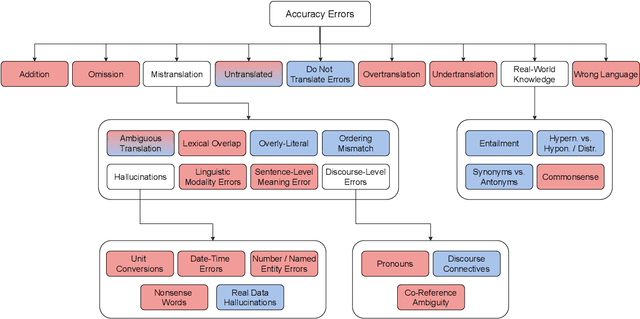


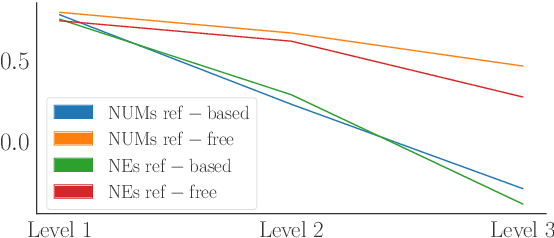
Abstract:We benchmark the performance of segmentlevel metrics submitted to WMT 2023 using the ACES Challenge Set (Amrhein et al., 2022). The challenge set consists of 36K examples representing challenges from 68 phenomena and covering 146 language pairs. The phenomena range from simple perturbations at the word/character level to more complex errors based on discourse and real-world knowledge. For each metric, we provide a detailed profile of performance over a range of error categories as well as an overall ACES-Score for quick comparison. We also measure the incremental performance of the metrics submitted to both WMT 2023 and 2022. We find that 1) there is no clear winner among the metrics submitted to WMT 2023, and 2) performance change between the 2023 and 2022 versions of the metrics is highly variable. Our recommendations are similar to those from WMT 2022. Metric developers should focus on: building ensembles of metrics from different design families, developing metrics that pay more attention to the source and rely less on surface-level overlap, and carefully determining the influence of multilingual embeddings on MT evaluation.
Evaluating the Effectiveness of Natural Language Inference for Hate Speech Detection in Languages with Limited Labeled Data
Jun 10, 2023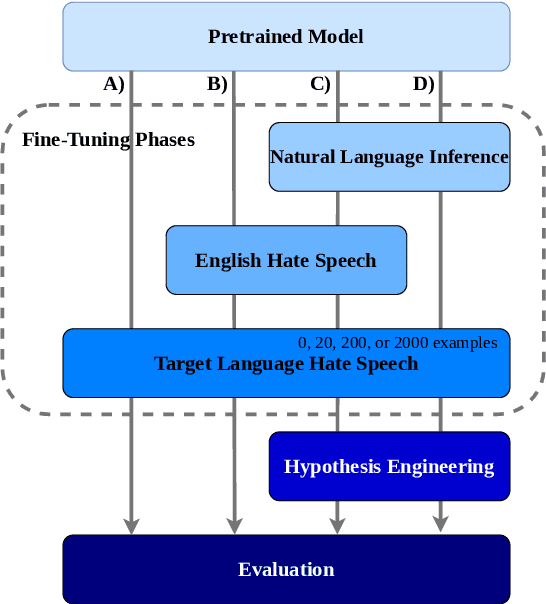
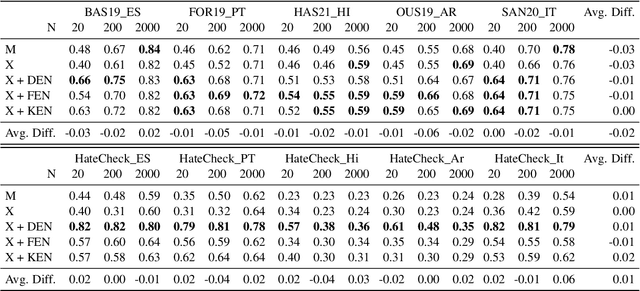
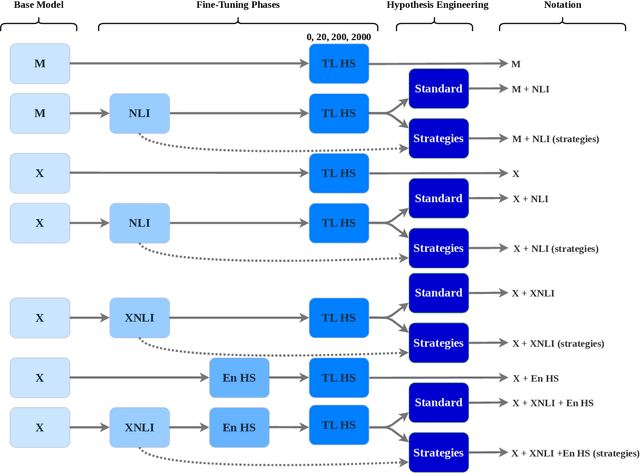
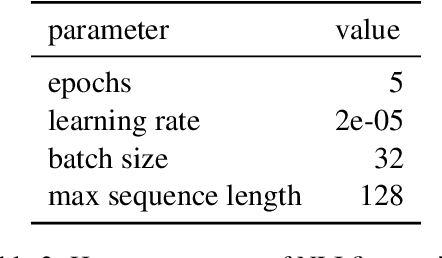
Abstract:Most research on hate speech detection has focused on English where a sizeable amount of labeled training data is available. However, to expand hate speech detection into more languages, approaches that require minimal training data are needed. In this paper, we test whether natural language inference (NLI) models which perform well in zero- and few-shot settings can benefit hate speech detection performance in scenarios where only a limited amount of labeled data is available in the target language. Our evaluation on five languages demonstrates large performance improvements of NLI fine-tuning over direct fine-tuning in the target language. However, the effectiveness of previous work that proposed intermediate fine-tuning on English data is hard to match. Only in settings where the English training data does not match the test domain, can our customised NLI-formulation outperform intermediate fine-tuning on English. Based on our extensive experiments, we propose a set of recommendations for hate speech detection in languages where minimal labeled training data is available.
Exploiting Biased Models to De-bias Text: A Gender-Fair Rewriting Model
May 18, 2023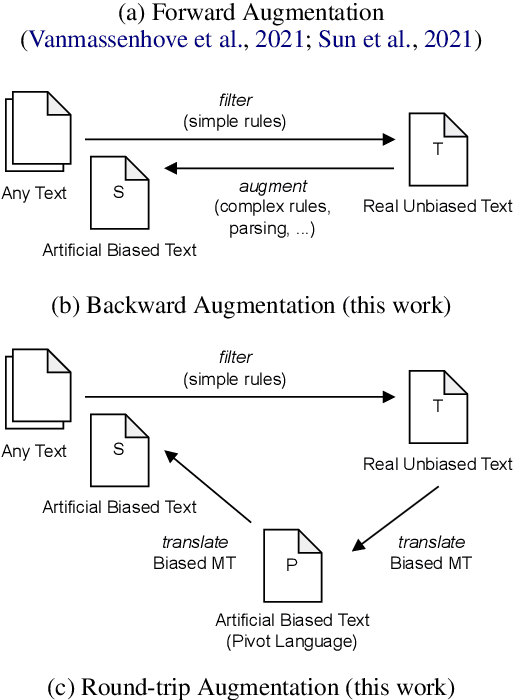



Abstract:Natural language generation models reproduce and often amplify the biases present in their training data. Previous research explored using sequence-to-sequence rewriting models to transform biased model outputs (or original texts) into more gender-fair language by creating pseudo training data through linguistic rules. However, this approach is not practical for languages with more complex morphology than English. We hypothesise that creating training data in the reverse direction, i.e. starting from gender-fair text, is easier for morphologically complex languages and show that it matches the performance of state-of-the-art rewriting models for English. To eliminate the rule-based nature of data creation, we instead propose using machine translation models to create gender-biased text from real gender-fair text via round-trip translation. Our approach allows us to train a rewriting model for German without the need for elaborate handcrafted rules. The outputs of this model increased gender-fairness as shown in a human evaluation study.
ACES: Translation Accuracy Challenge Sets for Evaluating Machine Translation Metrics
Oct 27, 2022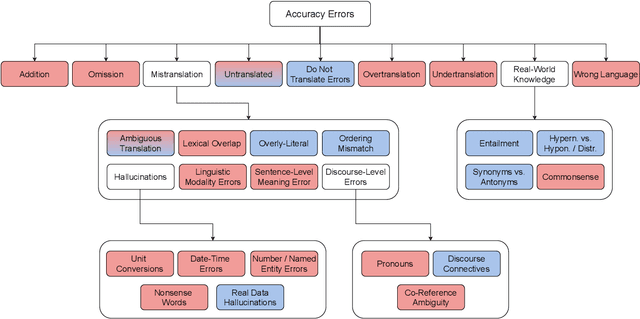
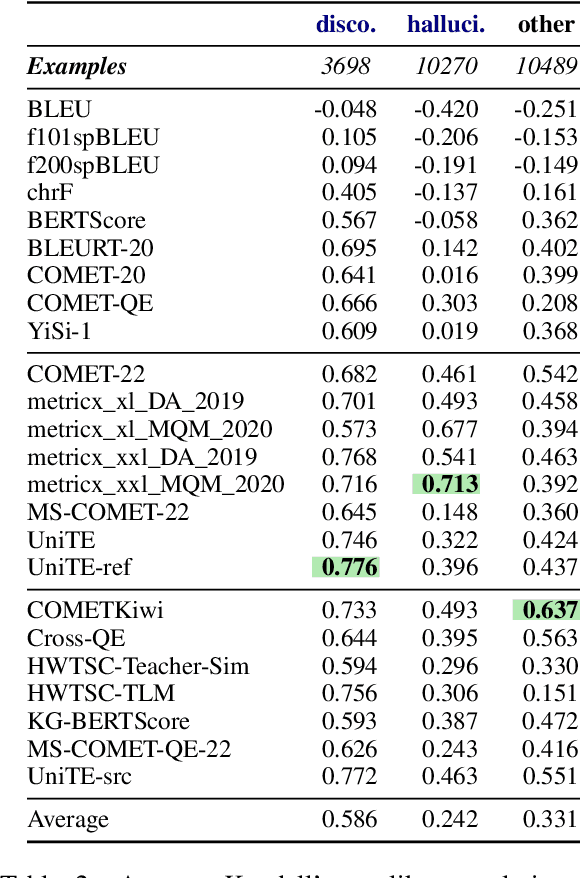
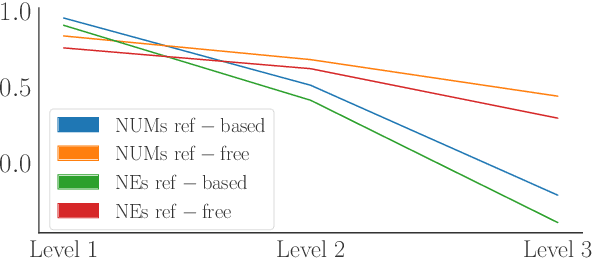
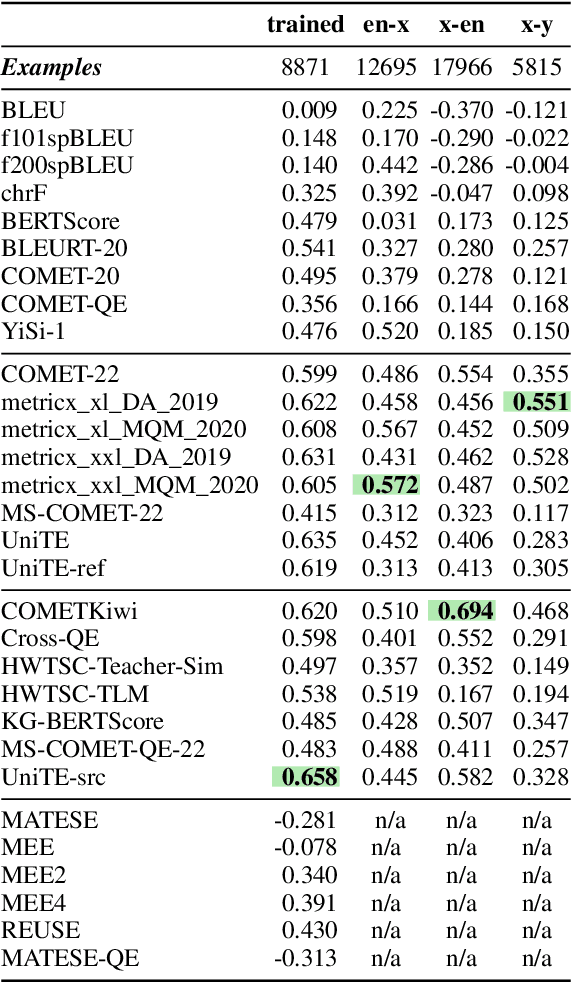
Abstract:As machine translation (MT) metrics improve their correlation with human judgement every year, it is crucial to understand the limitations of such metrics at the segment level. Specifically, it is important to investigate metric behaviour when facing accuracy errors in MT because these can have dangerous consequences in certain contexts (e.g., legal, medical). We curate ACES, a translation accuracy challenge set, consisting of 68 phenomena ranging from simple perturbations at the word/character level to more complex errors based on discourse and real-world knowledge. We use ACES to evaluate a wide range of MT metrics including the submissions to the WMT 2022 metrics shared task and perform several analyses leading to general recommendations for metric developers. We recommend: a) combining metrics with different strengths, b) developing metrics that give more weight to the source and less to surface-level overlap with the reference and c) explicitly modelling additional language-specific information beyond what is available via multilingual embeddings.
Don't Discard Fixed-Window Audio Segmentation in Speech-to-Text Translation
Oct 24, 2022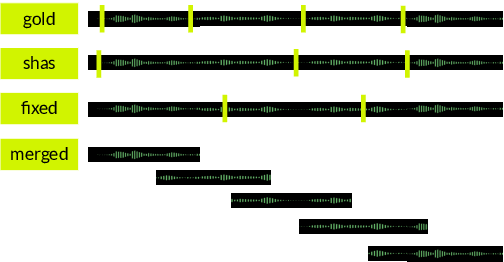
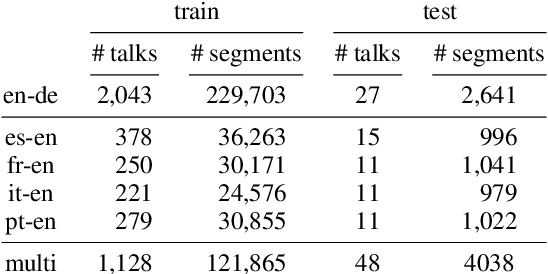
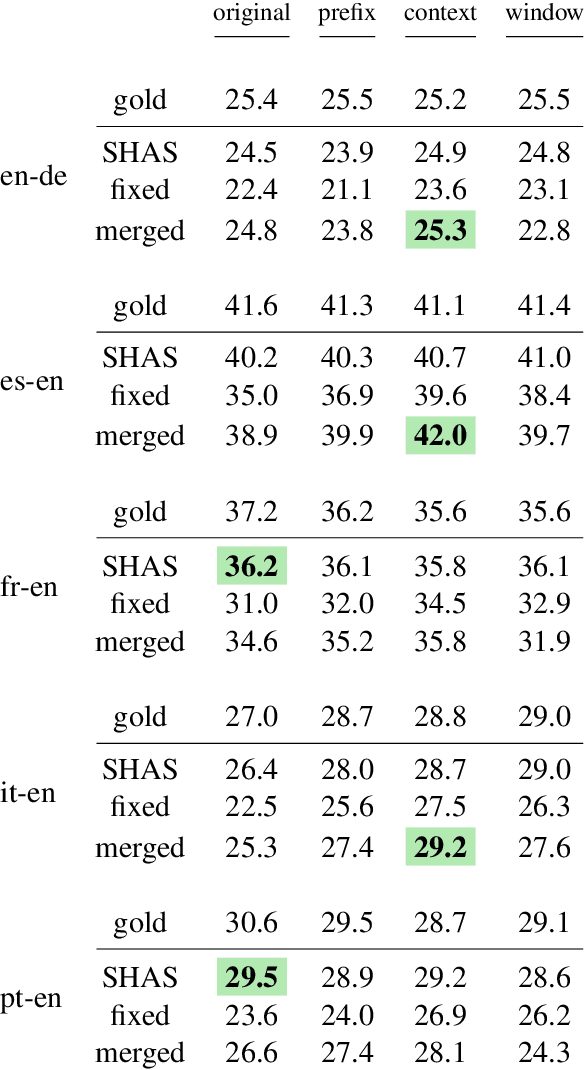
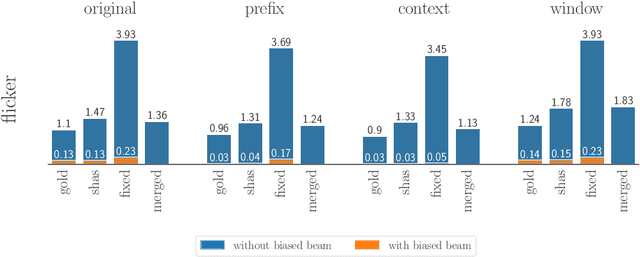
Abstract:For real-life applications, it is crucial that end-to-end spoken language translation models perform well on continuous audio, without relying on human-supplied segmentation. For online spoken language translation, where models need to start translating before the full utterance is spoken, most previous work has ignored the segmentation problem. In this paper, we compare various methods for improving models' robustness towards segmentation errors and different segmentation strategies in both offline and online settings and report results on translation quality, flicker and delay. Our findings on five different language pairs show that a simple fixed-window audio segmentation can perform surprisingly well given the right conditions.
Identifying Weaknesses in Machine Translation Metrics Through Minimum Bayes Risk Decoding: A Case Study for COMET
Feb 10, 2022
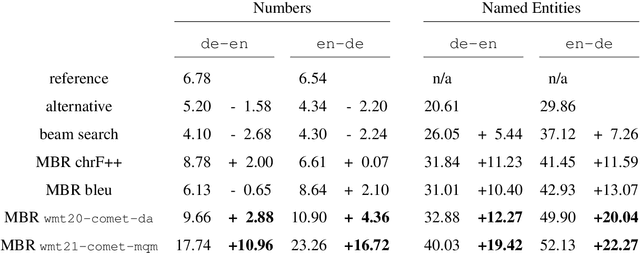
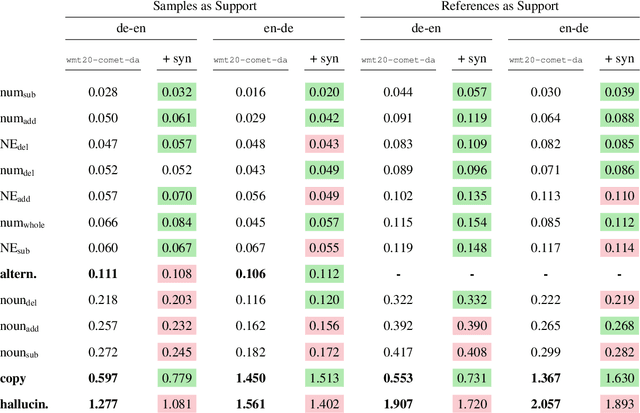
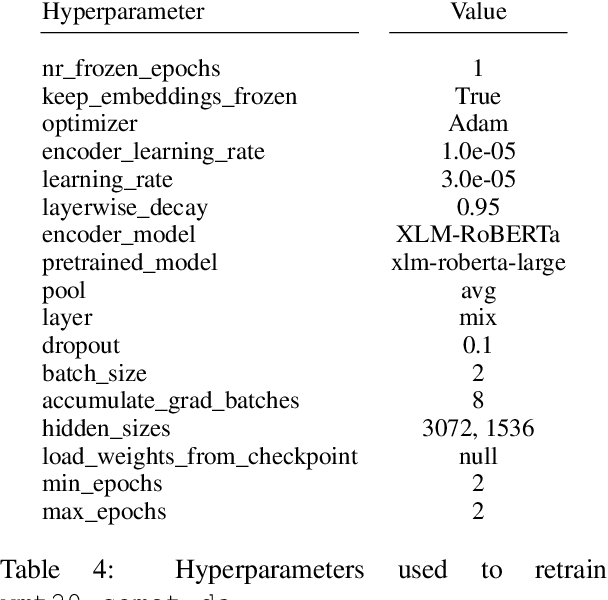
Abstract:Neural metrics have achieved impressive correlation with human judgements in the evaluation of machine translation systems, but before we can safely optimise towards such metrics, we should be aware of (and ideally eliminate) biases towards bad translations that receive high scores. Our experiments show that sample-based Minimum Bayes Risk decoding can be used to explore and quantify such weaknesses. When applying this strategy to COMET for en-de and de-en, we find that COMET models are not sensitive enough to discrepancies in numbers and named entities. We further show that these biases cannot be fully removed by simply training on additional synthetic data.
How Suitable Are Subword Segmentation Strategies for Translating Non-Concatenative Morphology?
Sep 02, 2021

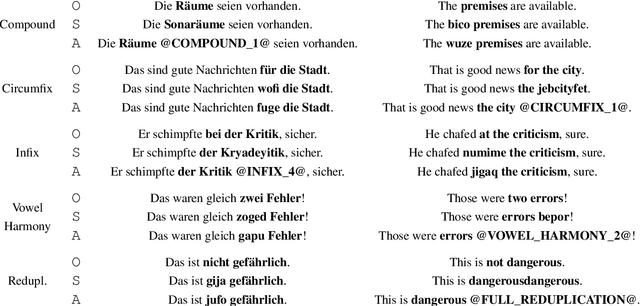

Abstract:Data-driven subword segmentation has become the default strategy for open-vocabulary machine translation and other NLP tasks, but may not be sufficiently generic for optimal learning of non-concatenative morphology. We design a test suite to evaluate segmentation strategies on different types of morphological phenomena in a controlled, semi-synthetic setting. In our experiments, we compare how well machine translation models trained on subword- and character-level can translate these morphological phenomena. We find that learning to analyse and generate morphologically complex surface representations is still challenging, especially for non-concatenative morphological phenomena like reduplication or vowel harmony and for rare word stems. Based on our results, we recommend that novel text representation strategies be tested on a range of typologically diverse languages to minimise the risk of adopting a strategy that inadvertently disadvantages certain languages.
 Add to Chrome
Add to Chrome Add to Firefox
Add to Firefox Add to Edge
Add to Edge